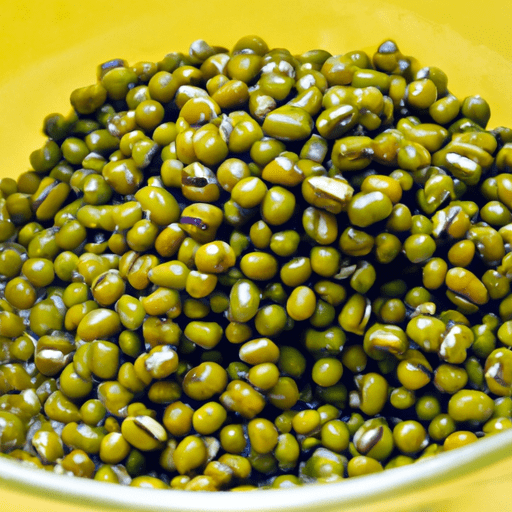The Versatility of Cooked Mung Beans: A Nutritious and Delicious Addition to Your Kitchen
Mung beans, also known as moong beans, are a versatile legume that has been a staple in many Asian cultures for centuries. These small green beans are packed with nutrients and offer a mild flavor that can be adapted to a variety of culinary creations. Whether you’re a seasoned chef or a home cook looking to experiment with new ingredients, cooked mung beans are worth considering for their taste, nutritional benefits, and interesting history.
Taste and Texture
Cooked mung beans have a subtle nutty flavor with a creamy texture, making them a delightful addition to numerous dishes. They have a pleasant earthiness that pairs well with a wide range of herbs, spices, and other ingredients commonly found in Asian cuisines. When cooked, mung beans have a soft texture that can lend itself to both soups and stews or be mashed to create creamy purees.
Culinary Uses
Due to their versatility, mung beans find their way into various recipes and dishes around the world. Here are a few popular ways to incorporate cooked mung beans into your culinary repertoire:
1. Dal and Soups
In Indian cuisine, cooked mung beans are often used to make dal, a flavorful lentil soup. Alongside aromatic spices like cumin, turmeric, and ginger, mung beans create a hearty and comforting dish that can be served with rice or flatbreads. Mung beans can also be used as a base for other soups, providing a nutritious and protein-rich addition.
2. Sprouts and Salads
Mung bean sprouts are commonly used in Asian cuisine and are a popular addition to stir-fries, salads, and noodle dishes. These crunchy and flavorful sprouts add a refreshing element to the dish and provide a burst of texture. Simply rinse the mung beans and let them sprout for a few days before enjoying their crispness in your favorite recipes.
3. Curries and Stir-Fries
Cooked mung beans can be incorporated into curries and stir-fries, absorbing the flavors of the other ingredients. Their soft texture blends well with a variety of vegetables, meats, or tofu, creating a balanced and satisfying meal.
4. Desserts
Believe it or not, mung beans also have a place in the world of desserts. In some Asian cuisines, they are used to make sweet treats like mung bean paste that is often used as a filling in traditional pastries and mooncakes. These desserts often combine mung beans with sugar, creating a delicate and unique flavor combination.
Nutritional Value
Apart from their delightful taste, mung beans are abundant in essential nutrients, making them a healthy addition to your diet. Here are some key nutritional highlights of cooked mung beans:
Protein: Mung beans are a great plant-based source of protein, making them an excellent choice for vegetarians and vegans. They are also rich in essential amino acids.
Fiber: These legumes are high in dietary fiber, supporting healthy digestion and providing a feeling of fullness.
Vitamins and Minerals: Mung beans are a good source of vitamins and minerals, including folate, magnesium, potassium, and iron.
Antioxidants: Mung beans contain various antioxidants that help protect the body’s cells from damage caused by harmful molecules called free radicals.
Interesting Facts and History
Mung beans have an intriguing history that spans over thousands of years. Here are a few fascinating facts about this versatile legume:
Mung beans have been cultivated in India and China since ancient times. They are one of the oldest known cultivated plants and have been a part of traditional Ayurvedic and Chinese medicine.
In some Asian cultures, mung beans are consumed during festivals and celebrations as they are believed to bring good luck and prosperity.
Mung bean sprouts gained popularity in the Western world after being introduced by Chinese immigrants in the early 20th century. Today, they are widely enjoyed and recognized for their crisp texture and nutritional value.
Mung bean starch is commonly used as a thickening agent in various food products, including noodles and desserts.
Conclusion
Cooked mung beans offer a versatile and nutritious option for enhancing your culinary repertoire. With their mild flavor and creamy texture, they can be incorporated into a wide range of dishes, from soups and salads to curries and desserts. Packed with essential nutrients, these legumes can contribute to a balanced and healthy diet. So why not add a bag of mung beans to your pantry and let your culinary creativity bloom?
Cooked Mung Beans
Origin: Mung beans, also known as green gram, are native to the Indian subcontinent. They have been cultivated for over 4,000 years and are widely used in Asian cuisine.
Common Uses: Cooked mung beans are used in a variety of dishes around the world. In Indian cuisine, they are used to make dal, a flavorful lentil soup. In Chinese cuisine, they are often used in stews and stir-fried dishes. In Southeast Asia, they are commonly used in salads and desserts.
Nutritional Benefits: Cooked mung beans are highly nutritious. They are a good source of protein, dietary fiber, and complex carbohydrates. They are also low in fat and contain important vitamins and minerals such as folate, manganese, magnesium, and potassium.
Unique Properties: One unique property of mung beans is their ability to sprout easily. Mung bean sprouts are commonly used in salads and stir-fried dishes. Another unique property is that mung beans are considered one of the easiest legumes to digest, making them a good choice for those with digestive issues.
Historical Significance: Mung beans have a rich history and have been used as a food source for centuries. In traditional Chinese medicine, mung beans are believed to have cooling properties, making them useful for balancing the body’s energy. In Ayurvedic medicine, mung beans are considered a dietary staple and are believed to be beneficial for detoxification and balancing the doshas (energies) of the body.




Use the share button below if you liked it.
It makes me smile, when I see it.